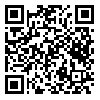Volume 1, Issue 1 (2020)
2020, 1(1): 55-67 |
Back to browse issues page
Download citation:
BibTeX | RIS | EndNote | Medlars | ProCite | Reference Manager | RefWorks
Send citation to:



BibTeX | RIS | EndNote | Medlars | ProCite | Reference Manager | RefWorks
Send citation to:
Motevallian N, Yeganeh M. Analysis of the Influence of Time Dimension on the National Symbol and Its Immediate Field. Urban Design Discourse
a Review of Contemporary Litreatures and Theories 2020; 1 (1) :55-67
URL: http://udd.modares.ac.ir/article-40-36739-en.html
a Review of Contemporary Litreatures and Theories 2020; 1 (1) :55-67
URL: http://udd.modares.ac.ir/article-40-36739-en.html
1- Architecture Department, Art & Architecture Faculty, Tarbiat Modares University, Tehran, Iran , naghmemotevallian@yahoo.com
2- Architecture Department, Art & Architecture Faculty, Tarbiat Modares University, Tehran, Iran
2- Architecture Department, Art & Architecture Faculty, Tarbiat Modares University, Tehran, Iran
Abstract: (4621 Views)
Since the national symbol is the most important urban element in terms of nationality, analyzing the influence of time on this symbol seems necessary. Less attention has been paid to the concept of time in the initial comments regarding urban issues. However, it was considered a serious matter after passing of time and observing its influence on urban and identity issues. The current study mainly aims to study the influence of time in the formation of the complex of national monuments, the direct and indirect influence of the time dimension on qualitative indicators of space and its influence on the appearance and semantic dimension of the national symbol and its immediate field. Thus, after reviewing the theoretical basics, many case studies of the world have been reviewed due to the lack of sufficient information and specialist investigations. Only nine case studies have been randomly selected and addressed in the present study. These studies are in line with theoretical basics and the thinkers’ ideas and they led to the final output. The descriptive-analytical method was used to gather the information and the outputs were analyzed by the survey method and Delphi tool for validation. The results show that the influence of time on the appearance dimension generally includes structural and apparent changes, erosion, deterioration, and ruin and the influence of time on the semantic dimension mostly includes semantic, identity, and revolutionary changes. In the qualitative indicators of the national symbol and its immediate field, the time dimension indirectly influences on some of indicators such as diversity, readability, permeability, visual richness, and vitality. In some indicators such as permeability and visual richness, the influence of time is associated with the appearance and in some indicators such as diversity, readability, and vitality, it is associated with appearance and semantic dimension. It is also influential in the quality of sustainability and efficiency in time dimension. Since there are two types of the national monuments in general, the influence of time dimension on them is different. Time triggers memory, meaning, layer structure and accessibility in the monuments built in the passing of time but it triggers patterns of receiving feature and lessons about designing such as observing flexibility and designing a timed and dramatic place in space.
Keywords: Urban Landmark, National Symbol, Immediate Field, National Monument Complex, Time Dimension
Article Type: Systematic Review |
Subject:
Quality of Urban Public Spaces
Received: 2019/09/23 | Accepted: 2019/10/8 | Published: 2020/03/15
Received: 2019/09/23 | Accepted: 2019/10/8 | Published: 2020/03/15
References
1. Pourjafar M, Montazerolhojjah M. Landmarks, definitions, typology, site selection, olanning and design. Tehran: Tahan Publications; 2010. [Persian] [Link]
2. Joao N. Landscape sculpture, the concept of time in emergence of landscape. Shakuri Moghaddam AR, Adelvand P, translators. Tehran: Manzar; 2011. [Persian] [Link]
3. Lynch K. What time is this place. Cambridge: MIT Press; 1972. [Link]
4. Carmona M. Public places, urban spaces: The dimensions of urban design. Oxford: Architectural Press; 2003. [Link]
5. Tibbalds F. Making people friendly towns: Improuing the public environment in towns and cities. Harlow: Longman; 1992. [Link]
6. Khaki Ghasr A. Exploration of order in architecture as a manifestation of quality. Art Archit Q. 2012;2(2):63-80. [Persian] [Link]
7. Motevalian N. Physical design performance of environment national landmark [Dissertation]. Tehran: Tarbiat Modares University; 2017. [Persian] [Link]
8. Zahedi A, Gooran F. Palimpsest Shahr-e Sukhteh. Archit Constr. 2004;1(3):20-7. [Persian] [Link]
9. Potts T. Rhythmanalysis: Space, time and everyday life. Architecture. 2015;20(3):550-4. [Link] [DOI:10.1080/13602365.2015.1052662]
10. Cullen G. The concise townscape. London: Arcitectural Press; 1971. [Link]
11. Lakoff G. The contemporary theory of metaphor. In: Sojoudi F, translator. Metaphor the basis of thinking and expressing beauty. Tehran: Sooreh Publications; 2004. [Persian] [Link]
12. Sojoudi F. Semiotics of time and passing of time, comparative study of verbal and visual works. J Acad Arts. 2006:1(1):46-64. [Persian] [Link]
13. Chandler D. Semiotics: The basic. London: Routeledge; 2002. [Link] [DOI:10.4324/9780203166277]
14. Bentley I. Responsive environments. New York: Architectural Press; 1985. [Link]
15. Lynch K. Appearance of the city. Mozayani M, translator. Tehran: Tehran University Publications; 1993. [Persian] [Link]
16. Lynch K. Theory of urban form. Bahraini H, translator. 2nd Edition. Tehran: Tehran University Publications; 2002. [Persian] [Link]
17. Jiang Sh, Ferreira J, Gonzalez MC. Discovering urban spatial-temporal structure from human activity patterns. KDD '12: The 18th ACM SIGKDD International Conference on Knowledge Discovery and Data Mining, 2012 August 12-16, Beijing, China. New York: Association for Computing Machinery; 2012. [Link] [DOI:10.1145/2346496.2346512]
18. Haselsteiner E, Smetschka B, Remesch A, Gaube V. Time-use patterns and sustainable urban form: A case study to explore potential links. Sustainability. 2015;7(6):8022-50. [Link] [DOI:10.3390/su7068022]
19. Kreitzman L. The 24 hour society. London: Profile Books Ltd; 1999. [Link]
Send email to the article author
| Rights and permissions | |
 |
This work is licensed under a Creative Commons Attribution-NonCommercial 4.0 International License. |







